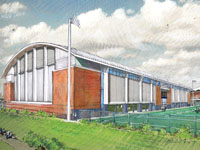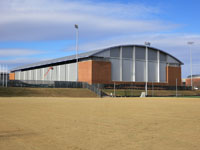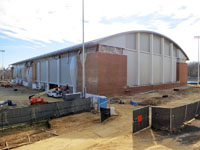 |
|
Artist’s rendition of the new George Welsh Indoor Practice Facility. |
Virginia’s new indoor practice facility is on schedule to be completed by late February and approved for use the first week of March, just in time for spring football training. During the early planning stages, the project was
initially estimated to begin during the spring of 2012 and be completed by August 2013, but according to UVa Executive Associate Athletics Director Jon Oliver the project is nearly complete.
What’s remarkable about that is that the $13 million facility, which didn’t break ground until summer of 2012, experienced a temporary setback when the south part of the roof was accidentally set on fire by a construction worker on Oct. 8. Yet the incident didn’t cause much down time.
“This project will be done and ready for spring practice,” Oliver said. “They quickly made up time, they just had to shift the way they were doing things. Obviously, when you have a building that large you do things in progression. So I think they just shifted ends and started at the other end while the repairs were being made. I don’t think they lost much time at all.”
The 78,000 square foot facility will include a 120-yard field with large doors that can be opened to face the practice field next to the McCue Center. The facility will be padded and have a 5-yard run off completely around the field. There will be 65 feet of vertical clearance, which will allow for a modest level of punting practice. The building will be climate controlled and offer other UVa ‘field’ sports to use the facility as well, with priority given to football. The facility also will have an automated video system, mainly for safety issues, which will include surveillance over the indoor field as well as the outdoor field. The building includes a filming platform as well as a netting system that will allow for field goals.
Many of the ACC’s member schools already have an indoor facility or have one in the planning stages, so this building is an important step in Virginia football program’s evolution.
“As Mike London came in he talked about needing this facility as the last piece to the overall student-athlete development,” said Oliver. “It was important to us. We think it will help with both recruiting and the ongoing development of our student-athletes. And the bottom line is – I think a lot of what a recruit does is they go to an institution to visit and they go through a checklist first; ‘Does this school have everything that every other school has?’ When you can accomplish that with recruits, then they can start to focus on the beauty of your place. We’ve got great locker room facilities, and we’ve got a great weight room and training room. This is clearly something we were lacking and was kind of the last piece to the puzzle.”
But Oliver was quick to point out that this facility isn’t just a response to what others are doing. “We study what other people are doing, not just in the ACC but around the country – the people who are going to compete against our student-athletes. And what we strive to do is make sure we have the right facilities for what we’re trying to do. Because, if you can’t do it that way you get caught up in the arms race, and we try to avoid that. But an indoor practice facility in this conference and around the country has become the norm, depending on where you are.”
And while a facility of this magnitude helps provide Coach London the tools necessary to recruit, it provides an incredible benefit with regard to quality practice time and unnecessary delays due to poor weather.
 |
 |
|
Photo of southern corner of facility (left) and the northern corner on Jan. 23. |
|
“Having the ability to utilize an indoor facility is critical to the continued development of the football program and the other sports that would be able to use it,” said Coach Mike London. “Without it, we have to alter, shorten or wait out the weather to conduct a proper practice and we are limited in the work we can do in the winter months. A majority of our competitors have or are in the planning stages of constructing an indoor facility. The ability to train, develop and maintain a competitive edge in an important element in attracting talent that would benefit from the Virginia experience on and off the field.”
While the project comes in at an estimated $13 million, the overall cost to UVa will be closer to $14.5 million due to interest on loans and timeline of commitment donations. A donation from one individual helped cover a large portion of the facility’s costs. But unlike the Carl Smith Center and John Paul Jones Arena, which were named after its largest donors, the $5 million that kicked off funding for the George Welsh Indoor Practice Facility came via an anonymous donor.
“We hope our donors will recognize the impact that this facility will have on our program,” said VAF Executive Director Dirk Katstra, “and will help us by making an investment in the long-term success of the football program.”
Thus far, Virginia has gained commitments totally nearly $14 million, so another $500,000 or so is needed to completely cover construction and debt services costs.
“We’re still fundraising,” said Oliver. “It’s an exciting project and we can’t wait to get it done. At some point we’ll have an open house for the public to come see it, probably around the time we start spring practice.”
Donations can be made through the Virginia Athletics Foundation by calling 434-982-5025, or via the web site www.uvaindoorfacility.com. Fans also can view progress of the facility on TheSabre.com’s regularly updated page found here.



